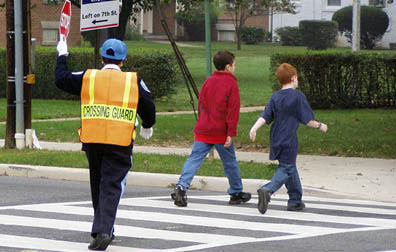NIOSH-funded Program Partners with Chiefs of Police to Reduce Traumatic Injuries Among New Jersey School Crossing Guards
August 2011
DHHS (NIOSH) Publication Number 2011-193

Crossing guard assists students in crossing a busy intersection. Photo by Arlington County, downloaded from flickr.
A Story of Impact:
School crossing guards play an important role in the safety of children in route to school, yet these workers are at risk for traumatic injuries. From 1993–2008, 120 crossing guards died on the job in the U.S.1 In the same period, the New Jersey Fatality Assessment & Control Evaluation (NJ FACE) program in the New Jersey Department of Health and Senior Services (NJDHSS) identified 14 NJ school crossing guard fatalities.2 All 14 incidents involved local government employees struck by motor vehicles. Additionally, the number of nonfatal occupational injuries and illnesses involving days away from work for NJ crossing guards totaled 892, 14% of which were motor vehicle-related.3 The majority of the nonfatal injuries were slips, trips, and falls resulting in sprains, strains, and fractures.
After NJ FACE —funded by the National Institute for Occupational Safety and Health (NIOSH)—investigated a fatality of a school crossing guard, a statewide occupational health surveillance intervention project was initiated to prevent motor vehicle-related injuries and raise awareness of the occupation’s hazards.4 NJ school crossing guards are employed and trained by the municipality’s police department; hence, a key partner was the NJ Association of Chiefs of Police. Other stakeholders included the NJ State League of Municipalities, the NJ State Safety Council, the NJ Safe Routes to School Coalition, the NJDHSS Public Employees Occupational Safety and Health Program, and the NJ Municipal Excess Liability, a governmental risk-management organization with interest in crossing guard safety. NJ FACE developed a hazard alert titled Crossing Guards—Be Seen, Be Safe which included local and national injury data, job and safety training requirements, recommended and required personal protective equipment (PPE), safe work practice recommendations, and a compelling case study.5 All partners reviewed and endorsed the alert. An educational packet was mailed to all 534 NJ police departments with the alert and a survey designed to collect surveillance data and solicit feedback.
Relevant Information
- In a crosswalk, crossing guards and students are equally vulnerable.
- From 1993 to 2006, median days away from work for NJ school crossing guards almost always exceeded that for all local government occupations combined.6
- In NJ, about 5,390 crossing guards were employed in 2010; that is the 4th highest number in the nation.7
- Proper training and personal protective equipment for crossing guards could reduce traumatic injuries.
Impact




For more information, visit the NJDHSS Adult School Crossing Guardsweb site or the NIOSH FACE Program site.
References
1 U.S. Department of Labor, Bureau of Labor Statistics [2008]. Census of fatal occupational injuries, in cooperation with state and federal agencies. Unpublished data.
2 New Jersey Department of Health & Senior Services [2011]. Fatality assessment and control evaluation project. Unpublished data.
3 New Jersey Department of Labor & Workforce Development [2011]. Survey of occupational injuries and illnesses, in cooperation with the Bureau of Labor Statistics, U.S. Department of Labor. Unpublished data.
4 NIOSH [2006]. School crossing guard struck and killed by a sport utility vehicle. Fatality Assessment and Control Evaluation (FACE) Program, National Institute for Occupational Safety and Health, Centers for Disease Control and Prevention, U.S. Department of Health and Human Services. New Jersey Case Report 05-NJ-090. [https://www.cdc.gov/niosh/face/stateface/nj/05nj090.html]. Date accessed: June 2011.
5 New Jersey Department of Health & Senior Services [2011]. Crossing guards – be seen, be safe. [http://nj.gov/health/surv/documents/njcrossing_guards.pdf]. Date accessed: June 2011.
6 New Jersey Department of Health & Senior Services [2009]. Educational outreach to New Jersey adult school crossing guards: An occupational health surveillance intervention project. [http://nj.gov/health/surv/documents/xguardsrpt.pdf]. Date accessed: June 2011.
7 U.S. Department of Labor, Bureau of Labor Statistics [2010]. Occupational employment statistics. [http://www.bls.gov/oes/current/oes339091.htm]. Date accessed: June 2011.
SAFER • HEALTHIER • PEOPLE™
